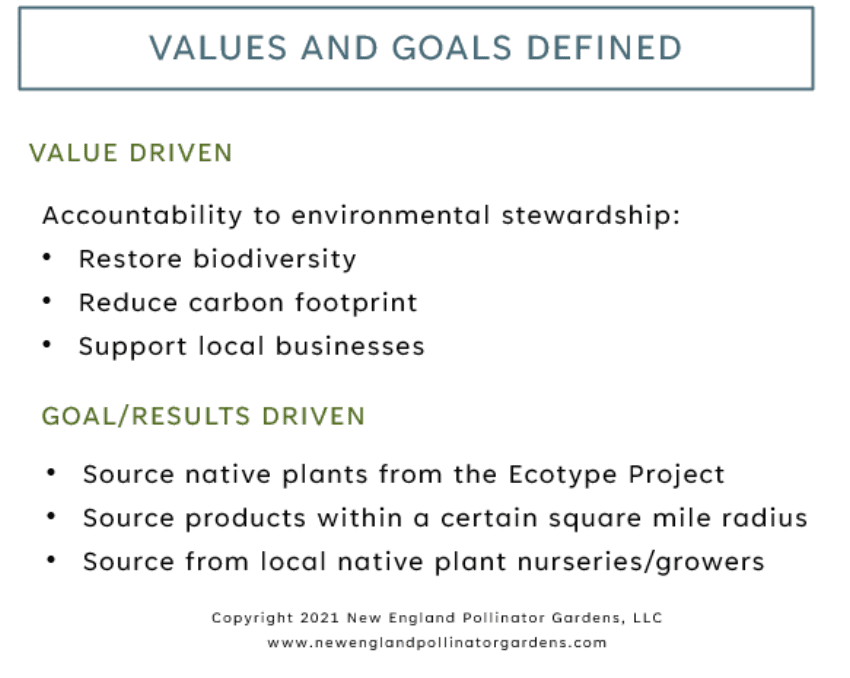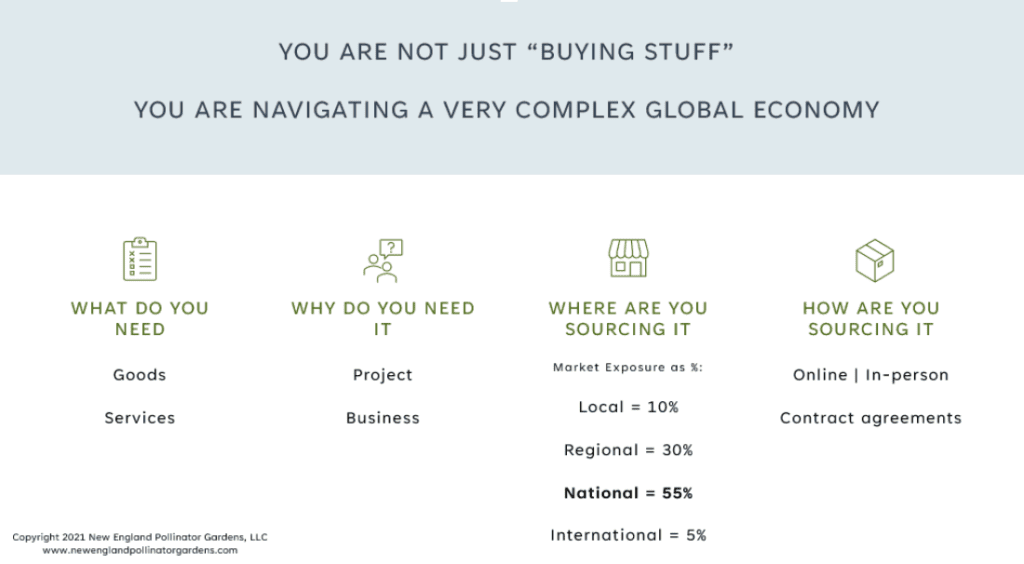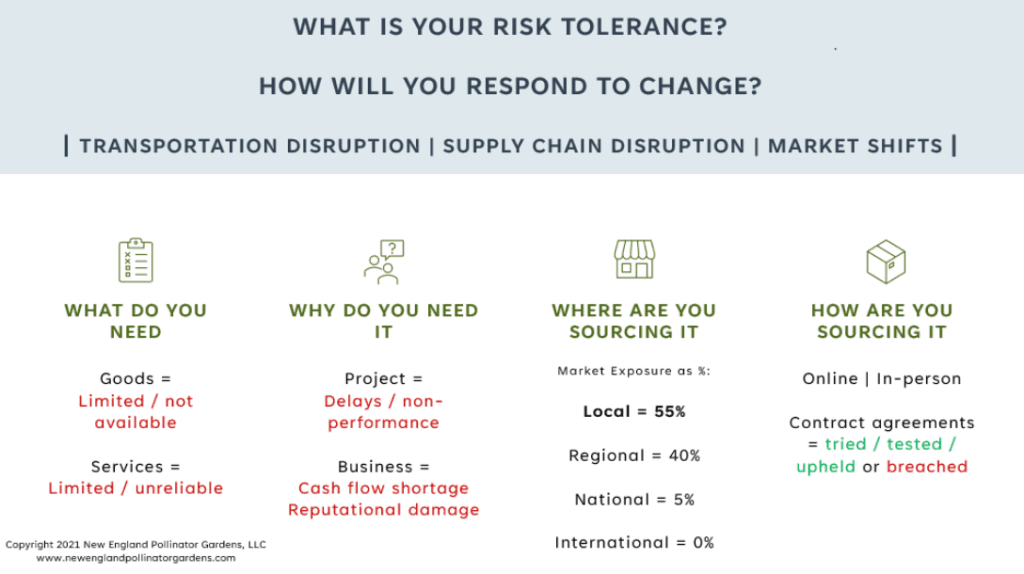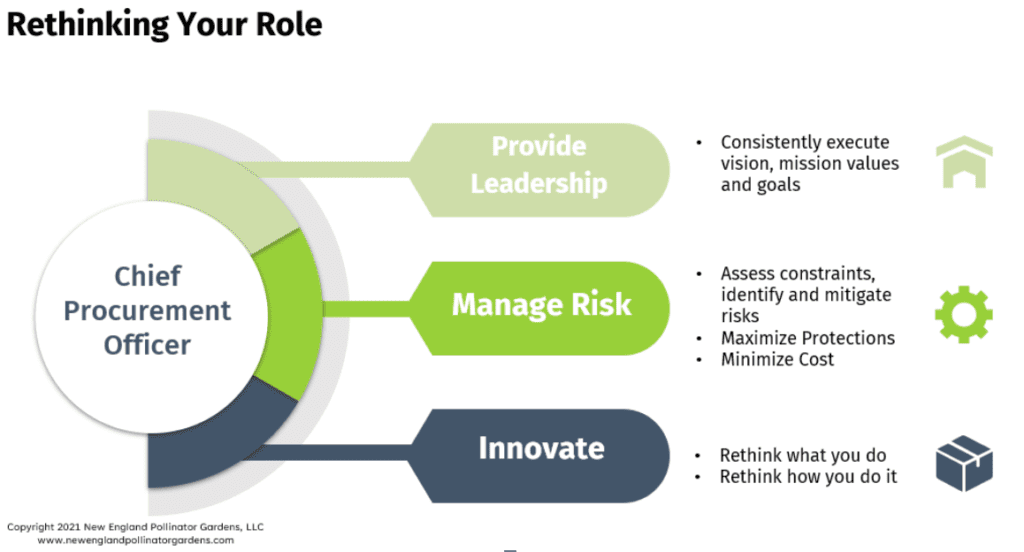By Michael Baczewski, MPA, AOLCP
In this two-part series explore how, in an era of supply chain chaos, climate crisis and greenwashing one New England based organic land care practitioner deploys strategic procurement to affect transformative change.
We buy stuff every single day, and it has never been easier.
Advances in information technology, automated intelligence and cloud computing have revolutionized how we enter markets. In less than a decade, these changes have facilitated a seismic shift in how we consume. Consumption has been re-engineered and along with it, so too have our expectations as consumers.
We consume with minimal concern, and up until this past year, not many of us are likely to recall any major supply chain disruptions in recent memory. Going to the store has been replaced by one click and items are delivered at our doorstep – sometimes that very same day. While conveniences abound there remains a confluence of ethical questions posed to each of us, especially as we think critically about the murkier side to consuming this way. The ease of “buying stuff” has become – in many instances – a mindless enterprise in which we may not have a complete perspective on the significant risks, the environmental consequences, nor possess the adequate time or resources required to perform comprehensive due diligence on suppliers and products.
When strategic procurement and sustainable sourcing are used together as non-mutually exclusive approaches, organic land care professionals can be positioned at the vanguard as leaders in environmental stewardship and perpetuate transformative change.
Developing a Holistic Procurement Strategy
While many of us subscribe to the belief that we are already experts in “buying,” when was the last time we put thought into why or if we even really need what it is we buy? Take a moment to think about the next three purchases your company or organization must make – these can be for goods or services. Think strategically about what you are buying, why you are buying it, how you are buying it, who you are buying it from and what the environmental and societal impact might be?
Now ask a colleague, business partner, or fellow board member to do the same.
Through this simple exercise, you may find that not only are the two sets of answers inconsistent but that your procurement strategy – the strategy by which you direct and deploy buying things business-wide – is nonexistent. If you find yourself at this crossroad, these questions can help guide you forward:
Define Values and Goals:
- How are my values and goals / my organization’s values and goals reflected in the purchases we make?
- How are my values and goals / my organization’s values or goals reflected in the products or services we sell to our clients?
- How are my values and goals / my organization’s values and goals reflected in the suppliers that comprise our supply chain?
- Am I / my organization willing to compromise our values or change our goals? If so, under what circumstances?
Defining your value system and goals and understanding how both interconnect are integral to thinking through a strategic lens. Ultimately, this framework drives and influences purchasing decisions and the procurement strategy of your business or organization.

Risk Management
Now think back to 2020 and even up until today. What challenges did you face in the market? Were you able to get supplies and services when you needed them? Were there delays? Unavailability? Did costs skyrocket? Did you lose money? Customers? Did you suffer reputational damage? Did you breach a contract agreement? Did you procure more supplies and inputs locally?
While certain supply chains literally eroded overnight, and the cost of goods and services fluctuated – in the gardening and landscaping sectors, we saw a statistical increase in consumer spending. Homeowners found refuge in their yards, investing in gardening and landscaping. Production levels of certain products hit all-time highs but manufacturers struggled to keep up with demand. Seed companies ran out of products for the first time in 80 years. Wholesalers were forced to rush to market inventory earlier than expected because of the surge in demand. This super challenging time made clear for many companies – conventional thinking had to be thrown out the window – the way of “business as usual” had to be disbanded.


Rethinking Your Role
Moving from “buying stuff” to understanding your role in a very complex global economy, you are making a seismic shift in your thinking and you are bringing added value to your business or organization. You are superseding that tendency to resort to antiquated logic, ease of consuming and static norms defined no better than the “I do it this way because our company has always done it this way” mentality. In doing so, you better position yourself and your company to adapt to change.
The shift from static thinking to dynamic thinking and reactionary decision making to prudent and defensible decision making – you become a chief procurement officer. And your roles and responsibilities become clearer as you engage in:
- Project Management
- Contract Management
- Inventory Management
- Supplier Management
- Contractor / Subcontractor Management
- Client Management
- Communication Management
- Compliance with regulations/laws
- Perform market analysis and due diligence
- Identify and respond to bid/RFP opportunities
- Develop and refine negotiation strategy(ies)
- Develop and improve marketing strategy(ies)
As a holistic business decision, strategic procurement becomes a vehicle for affecting transformative change and beyond simply “buying stuff.”

About the Author
Michael Baczewski specializes in strategic sourcing and procurement leadership. With over a decade of experience serving in various public sector capacities, Mike’s current role involves leading highly technical and diverse procurements ranging from information technology to disaster and emergency management.
Alongside his wife Brittney, the couple own New England Pollinator Gardens www.newenglandpollinatorgardens.com, a full-service ecological-based design and restorative land care company serving clientele throughout New England. The company sources exclusively from a vetted supply chain of local and regional – New England based – partners.
Professional certification and affiliations include: NOFA Organic Land Care Program, WildOnes and Doug Tallamy’s Homegrown National Park.
***
Each author appearing herein retains original copyright. Right to reproduce or disseminate all material herein, including to Columbia University Library’s CAUSEWAY Project, is otherwise reserved by ELA. Please contact ELA for permission to reprint.
Mention of products is not intended to constitute endorsement. Opinions expressed in this newsletter article do not necessarily represent those of ELA’s directors, staff, or members.

